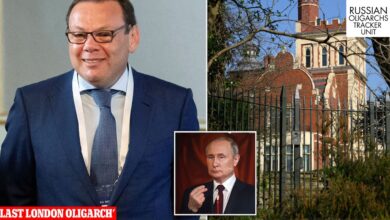US and Allies Target Russia with Sanctions in the Face of Ukraine Invasion
The protracted and devastating conflict known as the Russia-Ukraine war was sparked by Russia’s annexation of Crimea and its support for separatist rebels in eastern Ukraine in 2014. The region has suffered for a long time, with over a million people being displaced and a death toll exceeding fourteen thousand. There have been several attempts at a ceasefire, but fighting continues along the contact line on occasion.
With Russia’s full-scale invasion of Ukraine in 2022—which it justified as a mission to defend the Russian-speaking population in the Donbas region—tensions quickly erupted. Ukraine and its allies vigorously denounced this invasion and resisted it. In a quick response to the aggression, Ukraine received both military and humanitarian assistance, and sanctions were placed on Russia.

Along with creating a humanitarian crisis in the impacted area, the conflict raises the possibility of a larger conflict between Russia and NATO. The world community keeps a careful eye on the situation and works to find a diplomatic solution while also addressing the complexity of a conflict that transcends national boundaries, affects the lives of hundreds of thousands of people, and jeopardizes the stability of the geopolitical landscape.
Moreover, following Russia’s invasion of Ukraine in February 2022, Kyiv has received strong international support, with the United States spearheading this support. The United States and its allies opposed Moscow’s aspirations before the invasion, mobilizing diplomatic efforts and bolstering Ukraine’s military. They also warned of possible sanctions. The United States has played a significant role in giving Ukraine military hardware, instruction, financial support, and steadfast diplomatic backing since the invasion.
In an effort to thwart Russia’s offensive, the United States has also shared intelligence and issued strong warnings against the use of nuclear weapons. Think tanks’ advocacy, Ukraine’s lobbying for more aid, calls from both parties for the United States to penalize Russia, and the Biden administration’s gradual augmentation of its support all point to a possible future increase in American commitment to Ukraine.
Although the United States has expressed a commitment, policymakers have not explained how the current strategy fits with larger national goals. One emphasizes stopping Russian aggression in Ukraine in order to avert threats in the future, whether from Russia directly or as a warning to other aggressors such as China. These are the two main points of view that come to light. In the second, the conflict is framed as a test of democratic support and resistance to Russian revanchism, with the assertion that U.S. interests lie in upholding the liberal international order.
Recent Updates on Fresh Sanctions amid the escalating Ukraine conflict
The United States recently imposed sanctions on twelve Russian individuals and entities as part of a larger, coordinated effort with the G7 and other international partners to increase pressure on Russia in response to its invasion of Ukraine. The targeted sanctions are aimed at those who are involved in the transfer and testing of North Korean ballistic missiles, indicating their endorsement of Russia’s military intervention in Ukraine. Those who assist Russia’s energy sector and military-industrial complex are also subject to the sanctions.
The deliberate suspension of some export permits for dual-use goods is an attempt to keep Russia from acquiring supplies necessary for military operations. In the process, software, sensors, and electronics limit Russia’s combat capabilities. The United States has further extended the reach of its sanctions power by limiting access to new service categories and penetrating new sectors of the Russian economy. Apart from diminishing Russia’s capacity to carry out warfare, these comprehensive measures also intend to obstruct its endeavors to evade the prevailing sanctions.
Together, these comprehensive strategies demonstrate a commitment to address the Ukrainian issue by severing Russia’s military supplies and imposing stricter regulations on its economic activities, with the ultimate goal of compelling Russia to reconsider its actions in the region.
Furthermore, On January 15, 2024, the United States and its NATO allies jointly released a statement in which they harshly condemned Russia for persisting in its violations of the ceasefire in Ukraine. The statement emphasized the urgent need for Russia to immediately withdraw its troops and equipment from Ukrainian territory, reflecting a unified stance against the ongoing aggression. This denunciation demonstrates the alliance’s commitment to upholding international norms and protecting Ukraine’s sovereignty.

Apart from denouncing Russia’s actions, the joint statement emphasized the readiness of the United States and its NATO allies to strengthen their collective support for Ukraine. In addition to addressing Ukraine’s immediate defense needs, this expanded support is intended to strengthen the country’s security sector reform. The joint statement demonstrates a determined attempt to confront the changing difficulties brought on by Russia’s military actions by strengthening Ukraine’s ability to defend itself and enact necessary reforms.
The joint statement serves as a diplomatic tool to demonstrate the unwavering solidarity of the United States and its NATO allies against ongoing Russian aggression, as well as laying the framework for potential future actions to preserve stability and protect the interests of the affected countries. There is still a lot of tension in the area.
Countries Associated with the Conflict
Important parties and their alliances are involved in the conflict between Russia and Ukraine. The United States is the main military aid provider to Ukraine, giving it weapons, gear, and training. In addition to financial and humanitarian support, the United Kingdom has also given military assistance, both lethal and non-lethal.
The European Union gave Ukraine political and economic support while imposing sanctions on Russia. While Turkey has provided combat drones and offered moral and political support, Bulgaria has supplied Ukraine with weapons, ammunition, and fuel.
On the other hand, some countries back Russia’s incursion into Ukraine. Belarus has acknowledged the annexation of Crimea by allowing Russian troops to use its airspace and territory. Russia has been known to import equipment from Iran through the Caspian Sea.
Notably, Turkey, a NATO member, has raised questions about its alignment in the conflict by permitting Russian ships to pass through the Bosphorus Strait. The geopolitical environment is still complicated because different nations are supporting Ukraine’s defense in different ways or are siding with Russia.








